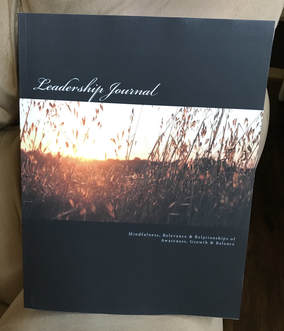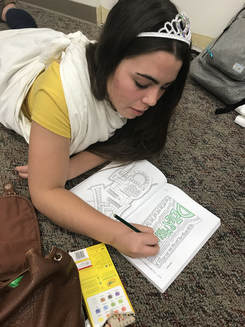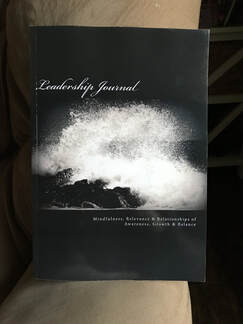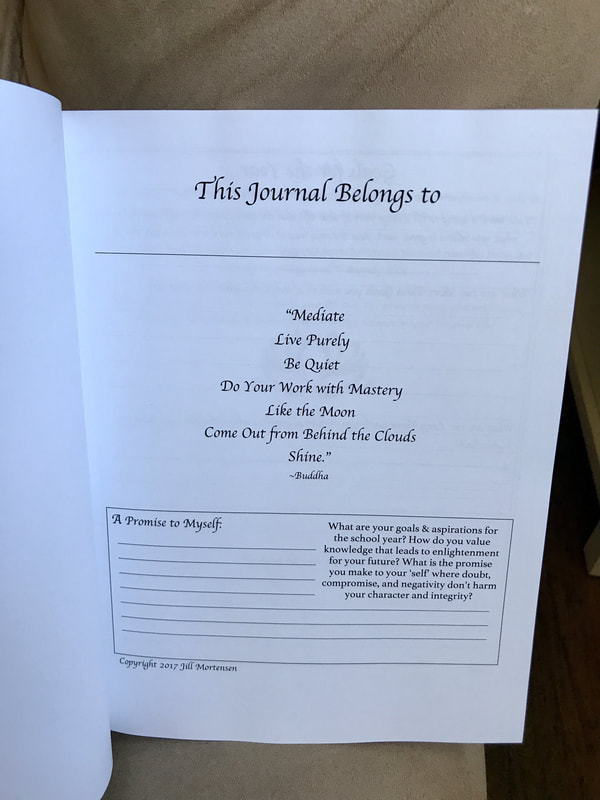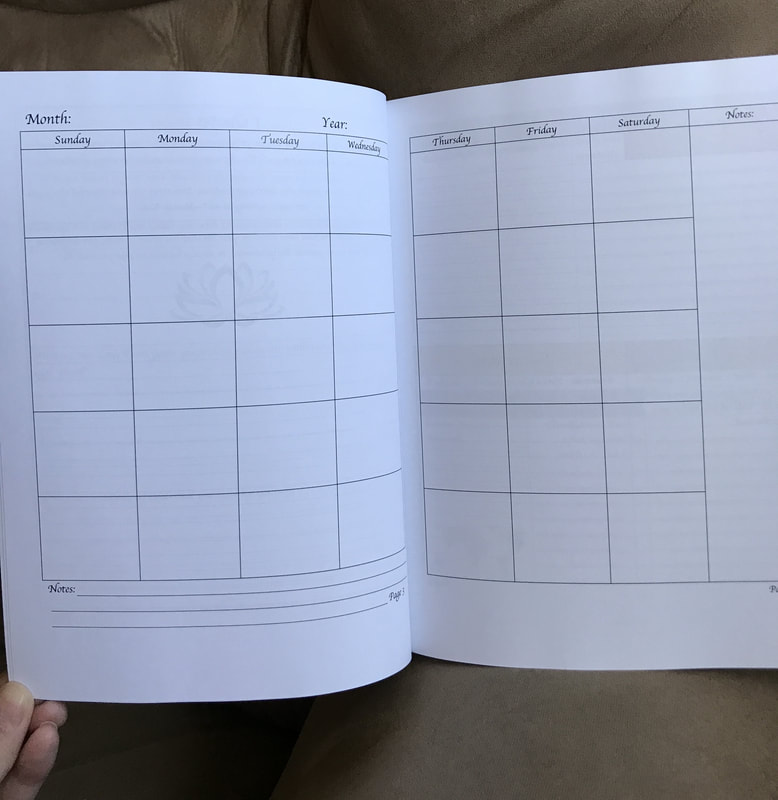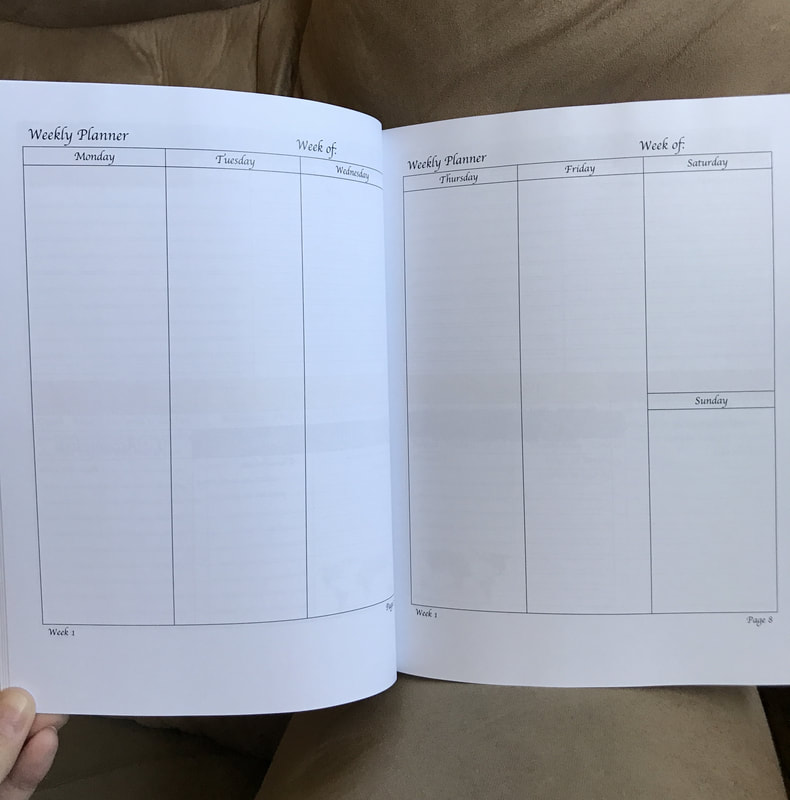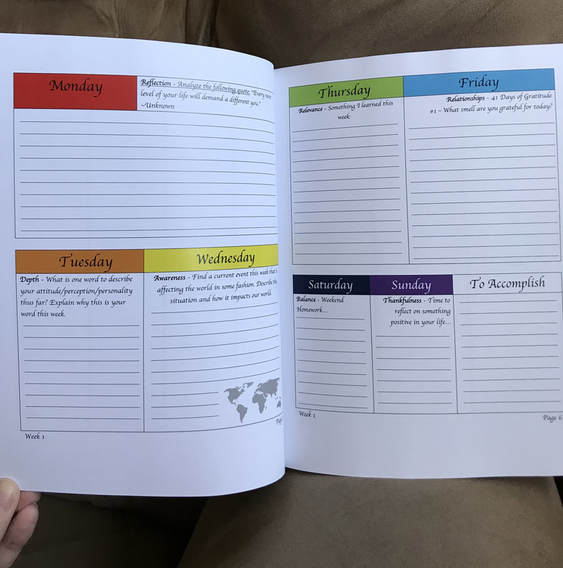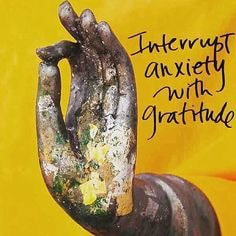Mindfulness, Relevance & Relationships of Awareness, Growth & Balance for the Teenage Mind
The journals found on this page have been an evolution of creativity and growth. These versions are still available on amazon, but the most up to date version will be found and explain at this link.
|
It is important to know that in order to create leaders, we must first explore our own self, build knowledge and confidence, before we can ask others to trust us and our leadership skills. I believe this journal can assist in creating stronger more confident leaders.
I have created a journal the first begins asking students to make a promise to themselves for the year. Here is the description promise: What are your goals & aspirations for the school year? How do you value knowledge that leads to enlightenment for your future? What is the promise you make to your ‘self’ where doubt, compromise, and negativity don’t harm your character and integrity? From there I ask the leadership students to plan goals set for the year – two short term, two long term, and two career related goals. It is my goal to have students look into the future to accomplish various ideas for the following year – to plan ahead with success. I then ask students to find a quote that defines their character and describe how it relates to their thoughts, ideas, goals and more. To focus on the power of words, their impact, and their shape allows our students to think more critically and analyze their true “self.” |
We then begin the journey to complete tasks daily in this journal. There are month calendars present so that we can keep track of when events occur. There are weekly calendars so that students can keep track of their homework along with tasks that have significant deadlines. Both aspects here align with the standards of my curriculum of time management, organization, and communication.
Each week the following will occur:
Mondays – Reflection: analyze a quote. The goal is to think more critically, analyze the meaning of words put together by an author, and reflect on the meaning behind the quote encouraging our students to be the best version of themselves.
Tuesdays – Depth: building on their vocabulary, students will pick a word that represents their current mood and why that word has impacted their day.
Wednesdays – Awareness: students will look to the world and find current events that are effecting local government, the state, federal government, or perhaps the world. The goal of student government is to be aware of our surroundings even if it does not directly affect our current state.
Thursday – Relevance: students will write down something they learned within the week, revisiting a concept that they found interesting, struggled with, found success with. Often we visit a topic for a short period of time and then forget. We must look back and find the relevance to the subject matter being taught.
Friday – Relationships: gratitude is so very important for our youth to learn. Our student needs to realize how fortunate and thankful they should be to have the life they have. Taking time to be thankful and reflective is so extremely important. Studies have shown that by showing gratitude/being thankful allows the body to ease from anxiety.
Saturday – Balance: students are asked to write down what they have for homework from that past week as a way to balance out their weekend and realize that deadlines are ahead of them.
Sunday – Thankfulness: A day to reflect and be thankful for family, friends, and more. Taking time to be still and writing down what they are thankful for that particular week.
Colors of each Day – Each day of the week is color coded representing the Chakras. The reason is for mindfulness. Our students are so busy each day with classes, sports, social media, family life, and more. What our students need is to remember to take time and be in the present. To be mindful of their surroundings. Through color, students can find balance and structure in their daily life.
Monday – Red: Root Chakra that represents time, self-protection, communication, balance.
Take time for the self and be rooted in all that you accomplish.
Tuesday – Orange: Sacral Chakra representing self-respect, creativity, and balance of relationships.
Take time to remember to respect yourself and all that you represent.
Wednesday – Yellow: Solar Plexus Chakra that represents self-worth, power, control and the work ethic to keep going.
Take the time to push through the good, bad, and even ugly days. Those goals scripted will be accomplished.
Thursday – Green: Heart Chakra is linked to love, kindness and caring.
We must as leaders remember to take care of others and treat them with kindness.
Friday – Teal Blue: Throat Chakra representing communication and creativity.
This is a goal for every leader, every day in the program.
Saturday – Dark Blue: Third Eye Chakra where reflection and mindfulness grow.
Leaders must be aware of others around them as they plan and execute activities. Not only that, but they must be mindful to their own needs and take care of themselves so that they can be successful is all that they do.
Sunday – Purple: Crown Chakra allows for connection and better relationships.
Leaders are able to put themselves aside and take care of others because their focus is to create strong and positive relationships.
Mondays – Reflection: analyze a quote. The goal is to think more critically, analyze the meaning of words put together by an author, and reflect on the meaning behind the quote encouraging our students to be the best version of themselves.
Tuesdays – Depth: building on their vocabulary, students will pick a word that represents their current mood and why that word has impacted their day.
Wednesdays – Awareness: students will look to the world and find current events that are effecting local government, the state, federal government, or perhaps the world. The goal of student government is to be aware of our surroundings even if it does not directly affect our current state.
Thursday – Relevance: students will write down something they learned within the week, revisiting a concept that they found interesting, struggled with, found success with. Often we visit a topic for a short period of time and then forget. We must look back and find the relevance to the subject matter being taught.
Friday – Relationships: gratitude is so very important for our youth to learn. Our student needs to realize how fortunate and thankful they should be to have the life they have. Taking time to be thankful and reflective is so extremely important. Studies have shown that by showing gratitude/being thankful allows the body to ease from anxiety.
Saturday – Balance: students are asked to write down what they have for homework from that past week as a way to balance out their weekend and realize that deadlines are ahead of them.
Sunday – Thankfulness: A day to reflect and be thankful for family, friends, and more. Taking time to be still and writing down what they are thankful for that particular week.
Colors of each Day – Each day of the week is color coded representing the Chakras. The reason is for mindfulness. Our students are so busy each day with classes, sports, social media, family life, and more. What our students need is to remember to take time and be in the present. To be mindful of their surroundings. Through color, students can find balance and structure in their daily life.
Monday – Red: Root Chakra that represents time, self-protection, communication, balance.
Take time for the self and be rooted in all that you accomplish.
Tuesday – Orange: Sacral Chakra representing self-respect, creativity, and balance of relationships.
Take time to remember to respect yourself and all that you represent.
Wednesday – Yellow: Solar Plexus Chakra that represents self-worth, power, control and the work ethic to keep going.
Take the time to push through the good, bad, and even ugly days. Those goals scripted will be accomplished.
Thursday – Green: Heart Chakra is linked to love, kindness and caring.
We must as leaders remember to take care of others and treat them with kindness.
Friday – Teal Blue: Throat Chakra representing communication and creativity.
This is a goal for every leader, every day in the program.
Saturday – Dark Blue: Third Eye Chakra where reflection and mindfulness grow.
Leaders must be aware of others around them as they plan and execute activities. Not only that, but they must be mindful to their own needs and take care of themselves so that they can be successful is all that they do.
Sunday – Purple: Crown Chakra allows for connection and better relationships.
Leaders are able to put themselves aside and take care of others because their focus is to create strong and positive relationships.
|
Weekly Coloring – Each week the students will have a coloring activity with a word embedded. Words like integrity, perseverance, focus, work, and more. It is important to have these leadership words a part of the course all year long reminding our students what they mean and how important they are to the program. Along with the word recognition, the coloring will allow the student to sit and be still with the artwork spending time in peace and working to be more mindful.
*Photos from Doodle Art Alley |
Why is Adult Coloring Beneficial to the Teenage Mind?
http://www.medicaldaily.com/therapeutic-science-adult-coloring-books-how-childhood-pastime-helps-adults-356280
The Therapeutic Science Of Adult Coloring Books: How This Childhood Pastime Helps Adults Relieve Stress
Coloring used to be reserved for children and the occasional adult who got to babysit them, but recently, the activity has found a different demographic. What started as a niche hobby has now turned into an international trend, as adult coloring books find themselves on more and more bestsellers’ lists throughout the world. However, while this trend may be a fun way to pass the time, it’s the books’ therapeutic properties that really have them flying off shelves.
The Healing Power Of Art
Art may not be able to cure disease, but it can surely make coping with it a lot better. Researchers have acknowledged the therapeutic qualities of art for years, and today, art therapy is used to help people express themselves when what they’re feeling is too difficult to put into words, such as when they’re faced with a cancer diagnosis.
Research shows this form of therapy often has tangible results. One 2006 study, for example, found that mindfulness art therapy for women with cancer helped to significantly decrease symptoms of physical and emotional distress during treatment. Another study from the same year concluded that after only one hour of art therapy, adult cancer patients of all ages “overwhelmingly expressed comfort” and a desire to continue with the therapy.
"People with cancer very often feel like their body has been taken over by the cancer. They feel overwhelmed," Joke Bradt, a music therapist at Drexel University in Philadelphia, told Reuters. "To be able to engage in a creative process... that stands in a very stark contrast to sort of passively submitting oneself to cancer treatments.”
It’s not just those with cancer that can benefit from the visual arts, either. Art therapy is also helpful among people dealing with a variety of other conditions, such as depression, dementia, anxiety, and PTSD.
Art therapy often involves using an art medium as a tool to help address a patient’s specific problem, but as you might have observed in your high school art class, some individuals are more artistically gifted than others. Those who judge themselves as bad artists may be more likely to miss out on the benefits of art-based therapies. Adult coloring, therefore, presents a creative venture without the need for artistic flair. One simply needs to color within the lines in order to get the desired effect. However, some experts suggest it’s this lack of artistic input from patients that prevents adult coloring from being considered a genuine form of art therapy.
“It’s like the difference between listening to music versus learning how to play an instrument,” Donna Betts, president of the board of the American Art Therapy Association told The Guardian. “Listening to music is something easy that everyone can do, but playing an instrument is a whole other skillset.”
Drena Fagen, an art therapist and adjunct instructor at New York University’s Steinhardt School, shared Betts’ sentiments: “I don’t consider the coloring books as art therapy,” she told The Guardian. “I consider the coloring books therapeutic, which is not the same thing.”
What’s Going On When We Color
Just because adult coloring alone may not constitute art therapy, that doesn’t mean the activity isn’t helpful. Theresa Citerella, an art therapy student at Lesley University in Cambridge, Mass., told Medical Daily that she has seen more people using the coloring books, both in class and in therapy, to help them focus.
“A lot of my fellow graduate classmates bring these coloring books into the classroom setting as a tool to focus more on lectures,” Citerella said, explaining that more professors are beginning to welcome this behavior. “For my internship, I find the clients who are fidgeting and cannot sit still ask for coloring the books in order to concentrate on group discussions. We have several adult coloring books at my site to offer the clients.”
And considering the inability to focus is often a symptom of anxiety or stress, it only makes sense that adult coloring books would also help with those as well. Dr. Stan Rodski, a neuropsychologist who also happens to be the author of his own line of adult coloring books, says that coloring elicits a relaxing mindset, similar to what you would achieve through meditation. Like mediation, coloring allows us to switch off our brains from other thoughts and focus on the moment. Tasks with predictable results, such as coloring or knitting, can often be calming — Rodski was even able to see the physical effects they had on our bodies by using advanced technology.
“The most amazing things occurred — we started seeing changes in heart rate, changes in brainwaves,” he told the Australian Broadcasting Corporation, adding that part of this neurological response in “colorists” comes from the repetition and attention to patterns and detail associated with coloring.
Dr. Joel Pearson, a brain scientist at the University of New South Wales in Australia presented a different explanation for the therapeutic effect: Concentrating on coloring an image may facilitate the replacement of negative thoughts and images with pleasant ones.
“You have to look at the shape and size, you have to look at the edges, and you have to pick a color,” Pearson told Nine MSN. “It should occupy the same parts of the brain that stops any anxiety-related mental imagery happening as well. ... Anything that helps you control your attention is going to help.”
The Therapeutic Science Of Adult Coloring Books: How This Childhood Pastime Helps Adults Relieve Stress
Coloring used to be reserved for children and the occasional adult who got to babysit them, but recently, the activity has found a different demographic. What started as a niche hobby has now turned into an international trend, as adult coloring books find themselves on more and more bestsellers’ lists throughout the world. However, while this trend may be a fun way to pass the time, it’s the books’ therapeutic properties that really have them flying off shelves.
The Healing Power Of Art
Art may not be able to cure disease, but it can surely make coping with it a lot better. Researchers have acknowledged the therapeutic qualities of art for years, and today, art therapy is used to help people express themselves when what they’re feeling is too difficult to put into words, such as when they’re faced with a cancer diagnosis.
Research shows this form of therapy often has tangible results. One 2006 study, for example, found that mindfulness art therapy for women with cancer helped to significantly decrease symptoms of physical and emotional distress during treatment. Another study from the same year concluded that after only one hour of art therapy, adult cancer patients of all ages “overwhelmingly expressed comfort” and a desire to continue with the therapy.
"People with cancer very often feel like their body has been taken over by the cancer. They feel overwhelmed," Joke Bradt, a music therapist at Drexel University in Philadelphia, told Reuters. "To be able to engage in a creative process... that stands in a very stark contrast to sort of passively submitting oneself to cancer treatments.”
It’s not just those with cancer that can benefit from the visual arts, either. Art therapy is also helpful among people dealing with a variety of other conditions, such as depression, dementia, anxiety, and PTSD.
Art therapy often involves using an art medium as a tool to help address a patient’s specific problem, but as you might have observed in your high school art class, some individuals are more artistically gifted than others. Those who judge themselves as bad artists may be more likely to miss out on the benefits of art-based therapies. Adult coloring, therefore, presents a creative venture without the need for artistic flair. One simply needs to color within the lines in order to get the desired effect. However, some experts suggest it’s this lack of artistic input from patients that prevents adult coloring from being considered a genuine form of art therapy.
“It’s like the difference between listening to music versus learning how to play an instrument,” Donna Betts, president of the board of the American Art Therapy Association told The Guardian. “Listening to music is something easy that everyone can do, but playing an instrument is a whole other skillset.”
Drena Fagen, an art therapist and adjunct instructor at New York University’s Steinhardt School, shared Betts’ sentiments: “I don’t consider the coloring books as art therapy,” she told The Guardian. “I consider the coloring books therapeutic, which is not the same thing.”
What’s Going On When We Color
Just because adult coloring alone may not constitute art therapy, that doesn’t mean the activity isn’t helpful. Theresa Citerella, an art therapy student at Lesley University in Cambridge, Mass., told Medical Daily that she has seen more people using the coloring books, both in class and in therapy, to help them focus.
“A lot of my fellow graduate classmates bring these coloring books into the classroom setting as a tool to focus more on lectures,” Citerella said, explaining that more professors are beginning to welcome this behavior. “For my internship, I find the clients who are fidgeting and cannot sit still ask for coloring the books in order to concentrate on group discussions. We have several adult coloring books at my site to offer the clients.”
And considering the inability to focus is often a symptom of anxiety or stress, it only makes sense that adult coloring books would also help with those as well. Dr. Stan Rodski, a neuropsychologist who also happens to be the author of his own line of adult coloring books, says that coloring elicits a relaxing mindset, similar to what you would achieve through meditation. Like mediation, coloring allows us to switch off our brains from other thoughts and focus on the moment. Tasks with predictable results, such as coloring or knitting, can often be calming — Rodski was even able to see the physical effects they had on our bodies by using advanced technology.
“The most amazing things occurred — we started seeing changes in heart rate, changes in brainwaves,” he told the Australian Broadcasting Corporation, adding that part of this neurological response in “colorists” comes from the repetition and attention to patterns and detail associated with coloring.
Dr. Joel Pearson, a brain scientist at the University of New South Wales in Australia presented a different explanation for the therapeutic effect: Concentrating on coloring an image may facilitate the replacement of negative thoughts and images with pleasant ones.
“You have to look at the shape and size, you have to look at the edges, and you have to pick a color,” Pearson told Nine MSN. “It should occupy the same parts of the brain that stops any anxiety-related mental imagery happening as well. ... Anything that helps you control your attention is going to help.”
Fox News Report
